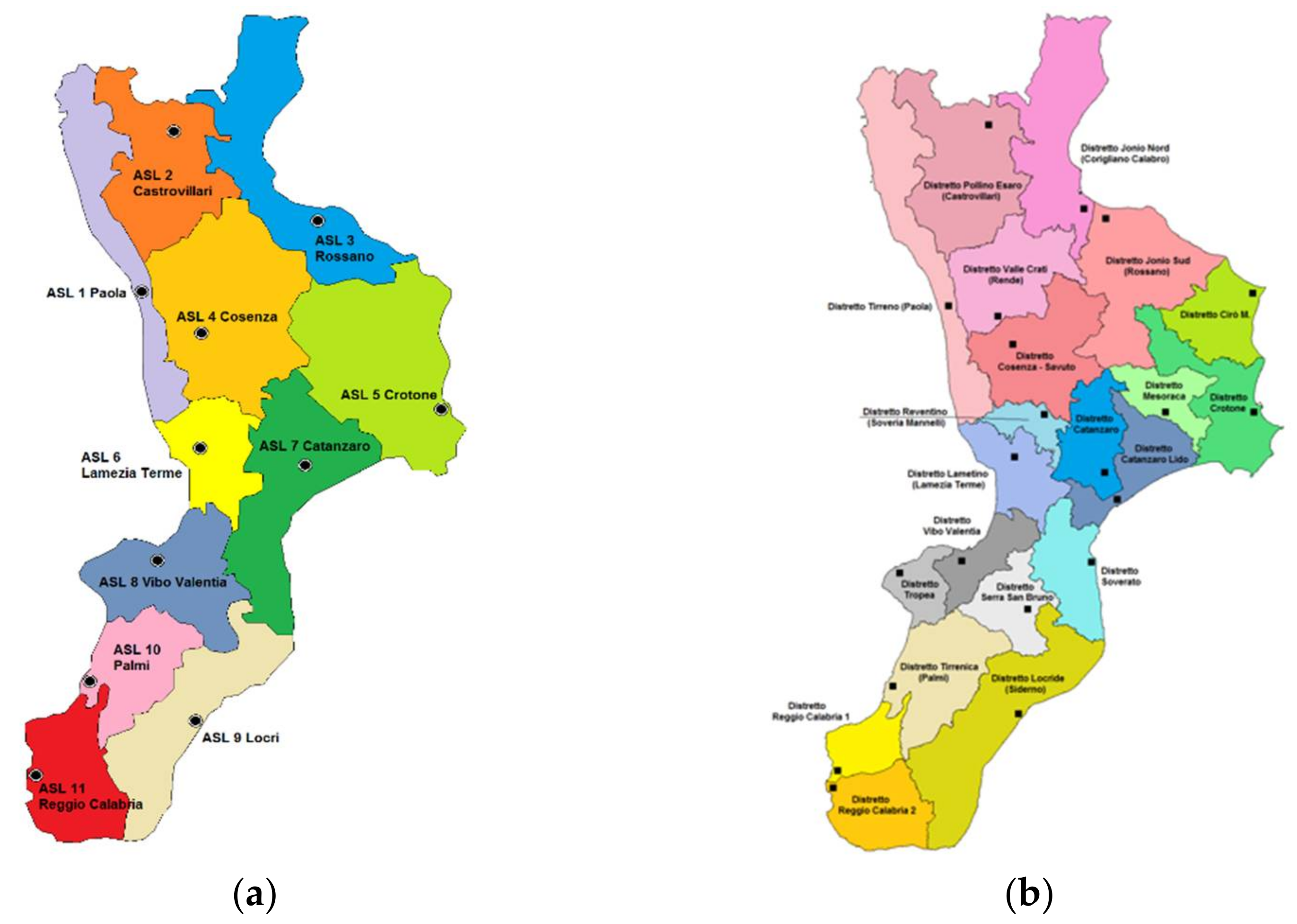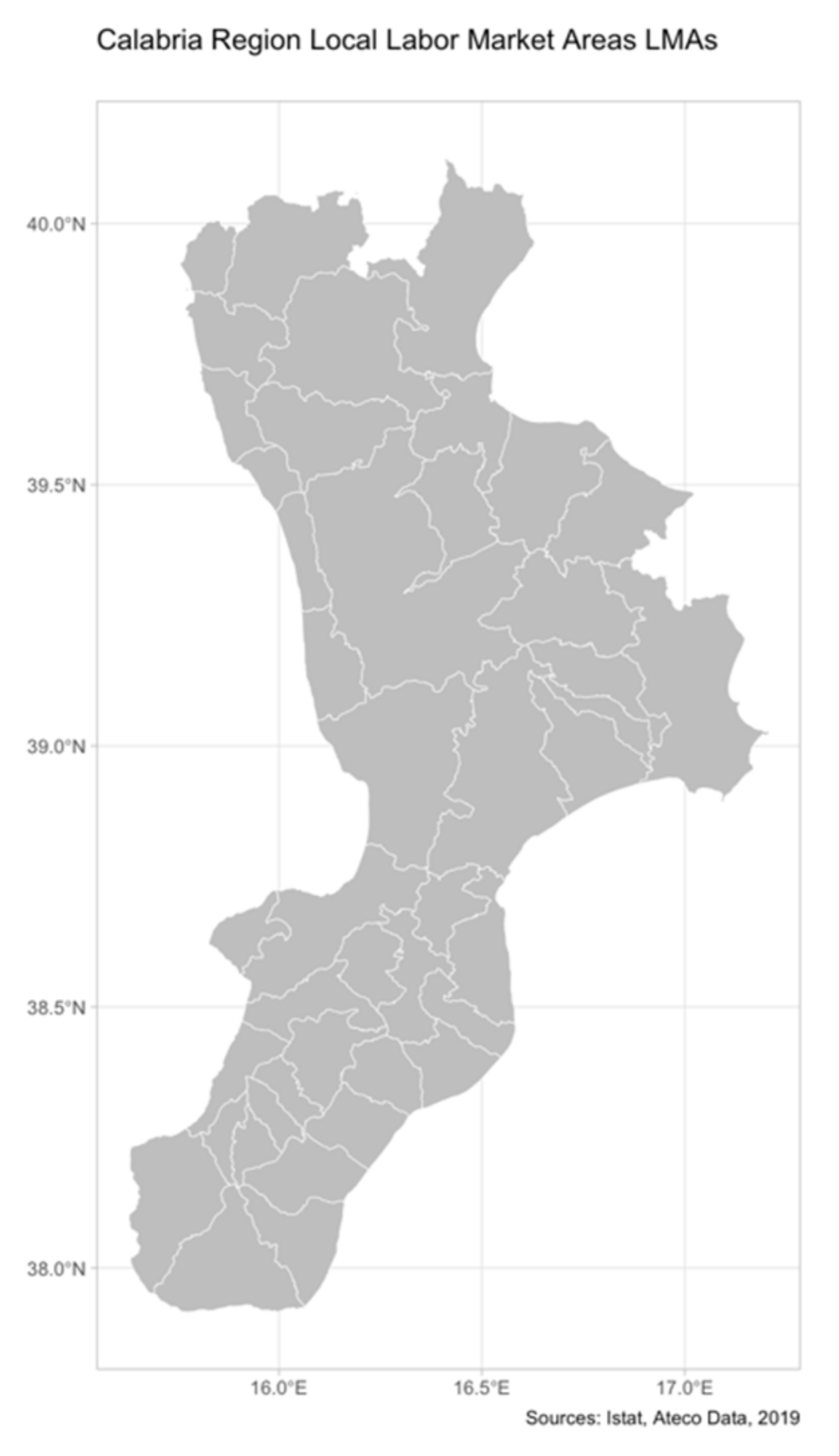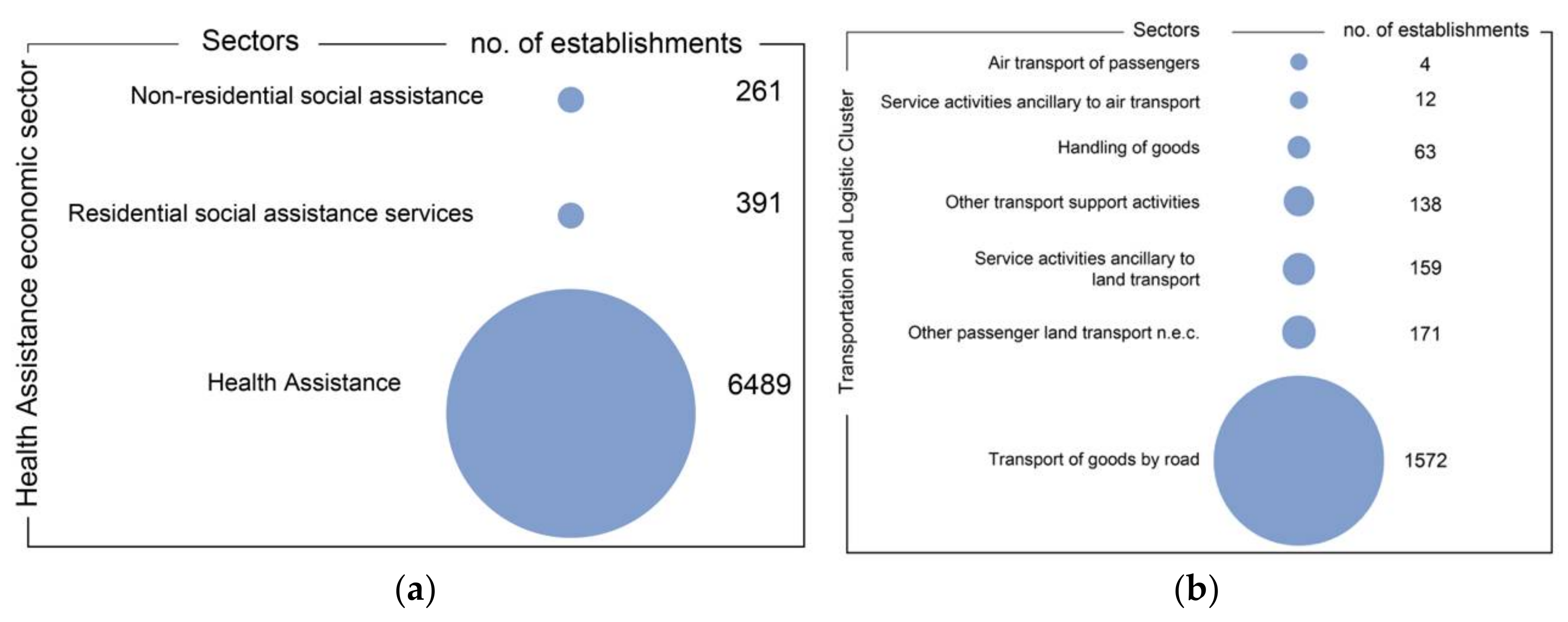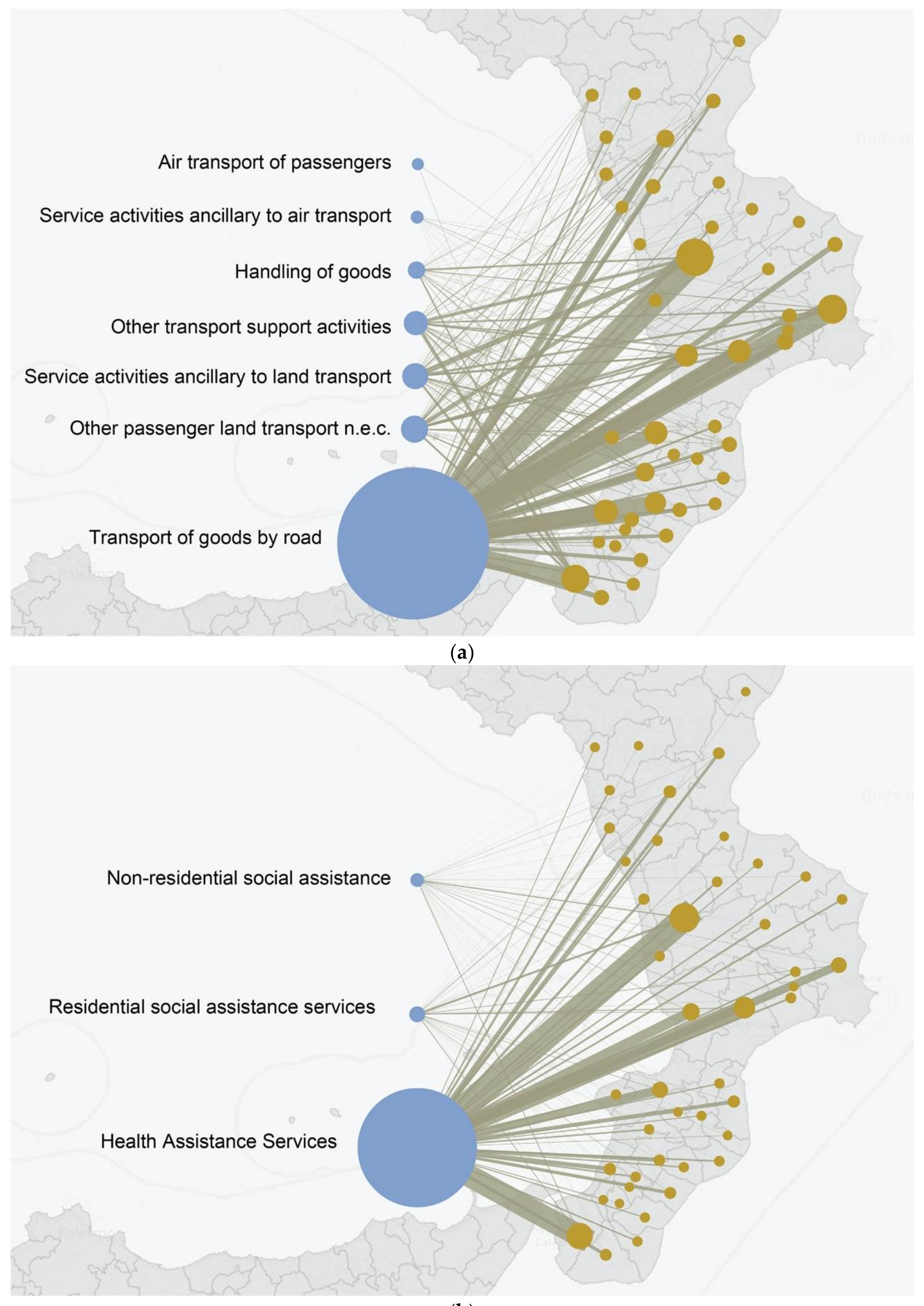From Deinstitutionalization to Community-Based Urban Development: Investigating Accessibility of Urban Systems in Calabria through Network Analytics
Abstract
:1. Introduction
2. Background
2.1. From Deinstitutionalization to Community-Based Urban Development
2.2. The Italian Policy Approach: Providing the Ground for Community-Based Urban Development
3. Methodology
3.1. Measuring Connectivity and Accessibility of Urban Systems in Calabria
3.2. Data Collection
3.3. Visualizing Connectivity and Accessibility of Urban Systems through Network Analysis Tools
4. Results and Discussion
5. Conclusions
Author Contributions
Funding
Institutional Review Board Statement
Informed Consent Statement
Data Availability Statement
Conflicts of Interest
References
- Eraydin, A. Resilience Thinking for Planning. In Resilience Thinking in Urban Planning, 2nd ed.; Eraydin, A., Taşan-Kok, T.B., Eds.; Springer: Dordrecht, The Netherlands, 2013; pp. 17–38. [Google Scholar]
- OECD. Fostering Economic Resilience in a World of Open and Integrated Markets Risks, Vulnerabilities and Areas for Policy Action. Available online: https://www.oecd.org/newsroom/OECD-G7-Report-Fostering-Economic-Resilience-in-a-World-of-Open-and-Integrated-Markets.pdf (accessed on 24 September 2021).
- European Commission. European Recovery Plan. Available online: https://ec.europa.eu/info/strategy/recovery-plan-europe_it (accessed on 24 September 2021).
- Community Based Urban Planning Toolkit (CBUPT) A Step-by-Step Approach to Community Based Urban Planning & Development in Zimbabwe. Available online: https://www.alnap.org/system/files/content/resource/files/main/51a4a069-8d54-48bd-b340-10230a000074.pdf (accessed on 30 November 2021).
- European Commission. Transition from Institutional to Community-Based Services (Deinstitutionalisation). Available online: https://ec.europa.eu/regional_policy/index.cfm/en/policy/themes/social-inclusion/desinstit (accessed on 14 October 2021).
- Bylund, J. Joint programming for urban transformations: The making of the JPI Urban Europe Strategic Research and Innovation Agenda. Urban Transform. 2020, 2, 10. [Google Scholar] [CrossRef]
- Schalock, R.L.; Brown, I.; Brown, R.; Cummins, R.A.; Felce, D.; Matikka, L.; Keith, K.D.; Parmenter, T. Conceptualization, measurement, and application of quality of life for persons with intellectual disabilities: Report of an international panel of experts. Ment. Retard. 2022, 6, 457–470. [Google Scholar] [CrossRef] [Green Version]
- Kozma, A.; Mansell, J.; Beadle-Brown, J. Outcomes in different residential settings for people with intellectual disability: A systematic review. Am. J. Intellect. Dev. Disabil. 2009, 3, 192–222. [Google Scholar] [CrossRef] [PubMed] [Green Version]
- Mansell, J.; Beadle-Brown, J. Dispersed or clustered housing for adults with intellectual disability: A systematic review. J. Intellect. Dev. Disabil. 2009, 34, 313–323. [Google Scholar] [CrossRef]
- The Ultimate Technical Guide to Urban Footprint. By Calthorpe Analytics. Available online: https://urbanfootprint.com/wp-content/uploads/2017/11/UrbanFootprint-Technical-Guide-v2-3.pdf (accessed on 12 September 2021).
- Zhang, F.; Dezhi, L.; Ahrentzen, S.; Zhanga, J. Assessing spatial disparities of accessibility to community-based service resources for Chinese older adults based on travel behavior: A city-wide study of Nanjing, China. Habitat Int. 2019, 88, 101984. [Google Scholar] [CrossRef]
- UN Urban Resilience Hub. Available online: https://urbanresiliencehub.org/articles/caring-beyond-city-lines/ (accessed on 10 October 2021).
- OECD. Can Social Protection Be an Engine for Inclusive Growth; Development Centre Studies, OECD Publishing: Paris, France, 2019. [Google Scholar] [CrossRef]
- Hughes, T.; Scott, K.; Maassen, P. Improving Public Services: Guidance for Developing. Available online: https://www.opengovpartnership.org/wp-content/uploads/2017/06/OGP_public-service-guidance.pdf (accessed on 20 October 2021).
- United Nations, Department of Economic and Social Affairs Sustainable Development. Available online: https://sdgs.un.org/goals (accessed on 28 October 2021).
- Gibson, D.; Angus, P.; Braddock, D.; Fortune, N.; Johnstone, H.; Madden, R.; Mason, F. Deinstitutionalisation: The Move Toward Community-Based Care. In Australias Welfare 2001: Services and Assistance; Australian Institute of Health and Welfare: Canberra, Australia, 2001; pp. 96–139. [Google Scholar]
- Emerson, E.; Hatton, C. Moving Out: The Impact of Relocation from Hospital to Community on the Quality of Life of People with Learning Disabilities; HM Stationery Office: London, UK, 1994. [Google Scholar]
- Kim, S.; Larson, S.A.; Lakin, K.C. Behavioural outcomes of deinstitutionalisation for people with intellectual disability: A review of US studies conducted between 1980 and 1999. J. Intellect. Dev. Disabil. 2001, 26, 35–50. [Google Scholar] [CrossRef]
- Mansell, J.; Knapp, M.; Beadle-Brown, J.; Beecham, J. Deinstitutionalisation and Community Living–Outcomes and Costs: Report of a European Study. Volume 2: Main Report; University of Kent: Canterbury, UK, 2007. [Google Scholar]
- Mansell, J.; Beadle-Brown, J. Deinstitutionalisation and community living: Position statement of the comparative policy and practice special interest research group of the international association for the scientific study of intellectual disabilities. J. Intellect. Disabil. Res. 2010, 54, 104–112. [Google Scholar] [CrossRef]
- Young, L.; Sigafoos, J.; Suttie, J.; Ashman, A.; Grevell, P. Deinstitutionalisation of persons with intellectual disabilities: A review of Australian studies. J. Intellect. Dev. Disabil. 1998, 23, 155–170. [Google Scholar] [CrossRef]
- Hatton, C.; Waters, J.; Duffy, S.; Senker, J.; Crosby, N.; Poll, C.; Tyson, A.; O’Brien, J.; Towell, D. A Report on In- Control’s Second Phase. In Evaluation and Learning 2005–2007; InControl: London, UK, 2008. [Google Scholar]
- Poll, C.; Duffy, S.; Hatton, C.; Sanderson, H.; Routledge, M. A Report on in Control’s First Phase, 2003-2005’; InControl Publications: London, UK, 2006. [Google Scholar]
- Deakin, M. A Community-Based Approach to Sustainable Urban Regeneration. J. Urban Technol. 2009, 16, 91–112. [Google Scholar] [CrossRef]
- Wilson, M.G.; Lavis, J.N.; Guta, A. Community-based organizations in the health sector: A scoping review. Health Res. Policy Syst. 2012, 10, 1–9. [Google Scholar] [CrossRef] [Green Version]
- Bruce, A.; Clarson, D. Assessing the potential and limits of community-based initiatives in urban regeneration: Three decades of experience on Sheffield’s Manor estate. Reg. Stud. Reg. Sci. 2017, 4, 80–93. [Google Scholar] [CrossRef] [Green Version]
- Sharifi, A.; Chelleri, L.; Fox-Lent, C.; Grafakos, S.; Pathak, M.; Olazabal, M.; Moloney, S.; Yumagulova, L.; Yamagata, Y. Conceptualizing Dimensions and Characteristics of Urban Resilience: Insights from a Co-Design Process. Sustainability 2017, 9, 1032. [Google Scholar] [CrossRef] [Green Version]
- Urban Europe, Joint European Solutions, Transition towards Sustainable and Liveable Urban Futures. The Strategic Research and Innovation Agenda of JPI Urban Europe. Available online: https://jpi-urbaneurope.eu/wp-content/uploads/2016/05/JPI-Urban-Europe-SRIA-Strategic-Research-and-Innovation-Agenda.pdf (accessed on 15 June 2021).
- Metropolis. The Metropolitan Scale of Resilience. Available online: https://www.metropolis.org/sites/default/files/issue_paper_3-the_metropolitan_scale_of_resilience.pdf (accessed on 20 October 2021).
- Noll, M.; Riegler, J.; Solerod, M.; Gollner, C.; Theierling, S. Driving Urban Transitions. Report on the Agora Strategic Dialogues, Urban Europe. Available online: https://jpi-urbaneurope.eu/wp-content/uploads/2020/10/DUT-AGORA-online-1.pdf (accessed on 22 July 2021).
- Bifulco, L.; Cementeri, L. Governance and Participation in Local Welfare: The Case of the Italian Piani di Zona. Soc. Policy Adm. 2008, 42, 211–227. [Google Scholar] [CrossRef]
- Regione Calabria, Piano Sociale 2020–2022. Available online: https://sis.welfarecalabria.it/resources/Piano%20Sociale_Regione%20Calabria_22.12.2020.pdf (accessed on 13 October 2021).
- Regione Campania, Politiche Sociali—Ambiti Territoriali. Available online: http://www.sito.regione.campania.it/politichesociali/ambiti_territoriali/index_ambiti_territoriali.htm (accessed on 15 October 2021).
- Regione Calabria, La Pianificazione Territoriale, le Linee di Indirizzo e la Connessione con la Programmazione per il Contrasto alla Povertaà e la Promozione Dell’inclusione Sociale. Available online: https://sis.welfarecalabria.it/sac/recuperadocumentopubblico/525521/0 (accessed on 15 October 2021).
- Regione Lombardia, Piano dei Servizi, Linee Guida alla Redazione. Available online: https://www.regione.lombardia.it/wps/wcm/connect/80e446dd-c205-460b-b4e5-9d39df50dafc/Piano+dei+Servizi+-+Linee+guida+alla+redazione.pdf?MOD=AJPERES&CACHEID=ROOTWORKSPACE-80e446dd-c205-460b-b4e5-9d39df50dafc-mlYcJMn (accessed on 24 October 2021).
- Porter, M. The economic performance of regions. Reg. Stud. 2003, 37, 549–578. [Google Scholar] [CrossRef]
- Frank, B.; Delano, D.; Schaefer-Caniglia, B. Urban systems: A socio–ecological system perspective. Sociol. Int. J. 2017, 1, 1–8. [Google Scholar] [CrossRef] [Green Version]
- Searle, G.; Sigler, T.J.; Martinus, K. Firm evolution and cluster specialization: A social network analysis of resource industry change in two Australian cities. Reg. Stud. Reg. Sci. 2018, 5, 369–387. [Google Scholar] [CrossRef] [Green Version]
- Sigler, T.J. After the ‘world city’has globalised: Four agendas towards a more nuanced framework for global urban research. Geogr. Compass 2016, 10, 389–398. [Google Scholar] [CrossRef]
- Huggins, R.; Prokop, D. Network structure and regional innovation: A study of university–industry ties. Urban Stud. 2017, 54, 931–952. [Google Scholar] [CrossRef]
- Cassi, L.; Morisson, A.; Ter Wal, A.L. The evolution of trade and scientific collaboration networks in the global wine sector: A longitudinal study using network analysis. J. Econ. Geogr. 2007, 7, 311–334. [Google Scholar] [CrossRef]
- Glückler, J. Economic geography and the evolution of networks. J. Econ. Geogr. 2007, 7, 619–634. [Google Scholar] [CrossRef] [Green Version]
- Grabher, G. Trading routes, bypasses, and risky intersections: Mapping the travels of networks’ between economic sociology and economic geography. Prog. Hum. Geogr. 2006, 30, 163–189. [Google Scholar] [CrossRef] [Green Version]
- Istat, Indagini sul Reddito e Condizioni di Vita. Available online: https://www.istat.it/it/files//2020/05/18_Calabria_Scheda.pdf (accessed on 18 October 2021).
- Eurostat, Gross Domestic Product (GDP) at Current Market Prices by NUTS 2 Region. Available online: https://ec.europa.eu/eurostat/web/main/data/database (accessed on 14 October 2021).
- Folta, T.B.; Cooper, A.C.; Baik, Y. Geographic cluster size and firm performance. J. Bus. Ventur. 2006, 21, 217–242. [Google Scholar] [CrossRef]
- Sölvell, Ö.; Ketels, C.; Lindqvist, G. Industrial specialization and regional clusters in the ten new EU member states. Compet. Rev. Int. Bus. J. 2008, 18, 104–130. [Google Scholar] [CrossRef]
- Istat, Labour Market Area: Eu-Ttwa Method: Improvements, Documentation and Sharing Knowledge Activities. Available online: https://www.istat.it/en/archive/182743 (accessed on 20 October 2021).
- Naumanen, M. European Panorama of Clusters And industrial Change: Emerging Industries: Driving Strength in 10 Cross-Sectoral Industries; European Commission EC: Publication Office of the European Union: Luxembourg, 2019. [Google Scholar]
- Istat, Classificazione Delle Attività Economiche ATECO 2007. Available online: https://www.istat.it/it/archivio/1788https://www.istat.it/it/archivio/17888 (accessed on 17 October 2021).
- Crosseley, N. The Social World of the Network. Combining Qualitative and Quantitative Elements in Social Network Analysis 2010. Sociologica 2010, 1, 1–34. [Google Scholar] [CrossRef]
- Costa, L.F.; Rodrigues, F.A.; Cristino, A.S. Complex networks: The key to systems biology. Genet. Mol. Biol. 2008, 31, 591–601. [Google Scholar] [CrossRef] [Green Version]
- Fletcher, R.; Barrett, N. Embeddedness and the evolution of global networks: An Australian case study. Ind. Mark. Manag. 2001, 30, 561–573. [Google Scholar] [CrossRef]
- Glueckler, J.; Doreian, P. Social network analysis and economic geography—positional, evolutionary and multi-level approaches. J. Econ. Geogr. 2016, 16, 1123–1134. [Google Scholar]
- OECD. OECD Policy Responses to Coronavirus (COVID-19) Cities Policy Responses. 2020. Available online: https://www.oecd.org/coronavirus/policy-responses/cities-policy-responses-fd1053ff/#section-d1e406 (accessed on 11 January 2022).
- Batty, M. Planning the 21st Century City—Four Snapshots for a New Science. Int. Rev. Spat. Plan. Sustain. Dev. 2021, 9, 1–9. [Google Scholar] [CrossRef]




| SD Goal/s | Aim |
|---|---|
| 3—Good health and well-being | Ensure healthy lives and promote well-being for all at all ages |
| 4—Quality education | Ensure inclusive and equitable quality education and promote lifelong learning opportunities for all |
| 10—Reduced inequalities | Reduce inequality within and among countries |
| 11—Sustainable cities and communities | Make cities and human settlements inclusive, safe, resilient and sustainable |
| 16—Peace, justice and strong institutions | Promote peaceful and inclusive societies for sustainable development, provide access to justice for all and build effective, accountable and inclusive institutions at all levels |
| Indicator | Calabria | Sicily | Campania | Puglia | Italy |
|---|---|---|---|---|---|
| Individual relative poverty rate (%) | 34.6 | 26.0 | 29.5 | 22.8 | 15.0 |
| Family relative poverty rate (%) | 30.6 | 22.5 | 24.9 | 20.0 | 11.8 |
| Indicator | Calabria | Sicily | Campania | Puglia | Italy |
|---|---|---|---|---|---|
| Gross Domestic Product (Millions of Euro) | 33,619.41 | 89,365.04 | 109,630.67 | 77,475.32 | 1,789,747 |
| Transportation and Logistics Cluster/Health and Social Assistance Sectors | ||
|---|---|---|
| Year | 2012–2018 | |
| Data | Number of active establishments local units | |
| Ateco 2007 | Data | Ateco Code 2007 by cluster |
| LMA code | Unit | |
| Italy | ||
| Sud | ||
| Calabria | ||
| 0000 | LMA | |
| Cluster | Sectors | LMAs Ateco Code |
|---|---|---|
| Transportation and Logistics | Repair and maintenance of aircraft and spacecraft | 3316 |
| Other passenger land transport n.e.c. | 4939 | |
| Transport of goods by road | 4941 | |
| Air transport of passengers | 5110 | |
| Cargo transportation by air | 5121 | |
| Service activities ancillary to land transportation | 5221 | |
| Service activities ancillary to air transport | 5223 | |
| Handling of goods | 5224 | |
| Other transport support activities | 5229 | |
| Health and Social Assistance | Health assistance | 86 (861, 862, 869) |
| Residential social assistance services | 87 (871, 872, 873) | |
| Non-residential social assistance | 88 (881, 889) |
Publisher’s Note: MDPI stays neutral with regard to jurisdictional claims in published maps and institutional affiliations. |
© 2022 by the authors. Licensee MDPI, Basel, Switzerland. This article is an open access article distributed under the terms and conditions of the Creative Commons Attribution (CC BY) license (https://creativecommons.org/licenses/by/4.0/).
Share and Cite
Bevilacqua, C.; Pizzimenti, P.; Hamdy, N.; Mangiulli, F. From Deinstitutionalization to Community-Based Urban Development: Investigating Accessibility of Urban Systems in Calabria through Network Analytics. Sustainability 2022, 14, 1348. https://doi.org/10.3390/su14031348
Bevilacqua C, Pizzimenti P, Hamdy N, Mangiulli F. From Deinstitutionalization to Community-Based Urban Development: Investigating Accessibility of Urban Systems in Calabria through Network Analytics. Sustainability. 2022; 14(3):1348. https://doi.org/10.3390/su14031348
Chicago/Turabian StyleBevilacqua, Carmelina, Pasquale Pizzimenti, Nourhan Hamdy, and Federica Mangiulli. 2022. "From Deinstitutionalization to Community-Based Urban Development: Investigating Accessibility of Urban Systems in Calabria through Network Analytics" Sustainability 14, no. 3: 1348. https://doi.org/10.3390/su14031348
APA StyleBevilacqua, C., Pizzimenti, P., Hamdy, N., & Mangiulli, F. (2022). From Deinstitutionalization to Community-Based Urban Development: Investigating Accessibility of Urban Systems in Calabria through Network Analytics. Sustainability, 14(3), 1348. https://doi.org/10.3390/su14031348






